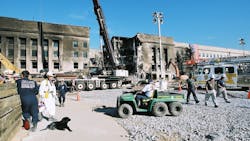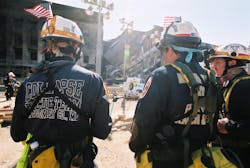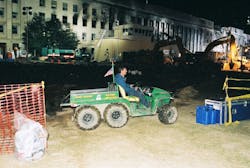On any typical day, getting onto Pentagon property isn’t a huge challenge. It’s a military installation. Access is controlled. There are protocols and controls for anyone entering the property and building. On September 11, 2001, those protocols and controls had to be recognized...and then disregarded as necessary for emergency response. The law enforcement patrol response wasn’t nearly as in depth as the firefighter response (and the first fire engine on scene was self-dispatched for the plane crash).
It would be overly simplistic to say that a variety of agencies responded to the scene when the attack occurred at the Pentagon that morning. To be clear on jurisdictions: While the Pentagon is located in Arlington County, Virginia, the jurisdiction of Arlington County Police Department and Arlington County Sheriff’s Office stop at the property line. The Pentagon is a military property under the control of the Secretary of Defense and is patrolled by Defense Protective Services; a federal law enforcement agency. Additionally, because of the nature of the attack (a terrorist attack), the Federal Bureau of Investigation (FBI) had primary jurisdiction over the investigation. Far beyond those four agencies, officers from at least ten other agencies responded and their efforts were coordinated/controlled by the Arlington County Police Department, the Defense Protective Services and the FBI. Some of the agencies involved in that response include the Arlington County Sheriff’s Office, the Virginia State Police, the Bureau of Alcohol, Tobacco, Firearms and Explosives (ATF), military police from Washington DC, the U.S. Secret Service, the EPA’s Criminal Investigations Division, the Air Force’s Office of Special Investigations, the National Transportation Safety Board and others. In total, it’s reported that over 2,000 law enforcement officers either responded to or were assigned in response to the attack on the Pentagon.On the morning of September 11, 2001, the Arlington County Emergency Communications Center was made aware of the pending crash. Two on duty officers saw the plane in steep descent, lined up to impact the Pentagon and radioed that information in. In response to the pending emergency conditions, the Arlington County Police Department put out a call to ALL officers, via issued pagers, to report for duty. It’s estimated that the on-duty officers were all alerted within just a few minutes while the remainder of the entire agency’s force was alerted within an hour and most of them were on scene within three hours.
Through pure circumstance, neither Chief Edward Flynn nor Deputy Chief Stephen Holl were in the county that morning. One was out of state and the other was in a different part of the state. Upon notification of the emergency, both men began immediate travel back to Arlington County. Another command staff member, Deputy Chief John Haas was also out of state and wasn’t able to get back as quickly. It was later determined that his delayed response was fortuitous. By the time he got back, a week later, the on-scene command staff members were both mentally and physically exhausted and Deputy Chief Haas was able to bring a fresh command outlook to the scene.
The first thing that had to be accomplished when the Arlington County Police Department arrived on the scene was to coordinate responsibility with the Defense Protective Services. It was determined that the Arlington County Police Department would assume responsibility for setting up and maintaining a secure outer perimeter.
With any large scale emergency, a command post location has to be selected and the Command Post set up. It has to be connected for power and communications and it has to be staffed. The location was specified by the Arlington County Police Department and that location was then placed under it’s own perimeter protection as well. At that point, all of the perimeter security manpower—both for the Pentagon and for the Emergency Command Post—was coming from the Arlington County Police Department. It’s a good thing they put out the call for all officers to report for duty.Just getting to the scene proved a challenge for many officers though. Along the way, due to traffic conditions, many of them had to stop and assist with traffic control, closing down certain roadways or specifying detours by hand. The ultimate goal was to clear a path for emergency response vehicles and personnel. One of the biggest challenges that occurs at a large scale emergency is that traffic jams inhibit or prohibit ambulances, fire trucks and other vehicles from being able to get to the scene. Recognizing this challenge and knowing a successful response predicated alleviating the challenge before it became response-prohibitive, many Arlington County police officers never made it to the scene but instead found themselves directing traffic or coordinating that reroute of flow.
The Arlington County Sheriffs Office personnel also responded appropriately. It become obvious quite quickly that a Mobile Command Post close to the scene would have to be supported by an Incident Command Post that was more permanent and at a more remote location. Each agency involved would also need its own information distribution hub. These were all management/command challenges that had to be addressed “on the fly.” Thankfully, each agency involved had an Emergency Operations Plan in place and had anticipated a variety of emergencies they’d have to manage.
One of the first things the Arlington County Sheriffs Office did was to evacuate and close all courthouse facilities. They did so with the approval and support of the Arlington County judiciary and, in doing so, freed up more deputies—normally assigned to courthouse duties—for the emergency response to the Pentagon.
For all of that, there were still enough Arlington County Police Department and Arlington County Sheriffs Office professionals responding that several arrived on scene at the Pentagon to assist with rescuing victims from inside the burning structure. They weren’t alone as they worked side-by-side with firefighters and military personnel, all stepping up to serve as needed in response.The Virginia State Police also responded, coordinating with all of the aforementioned agencies, and controlling/rerouting traffic on the nearby highways. All of the traffic on Interstate 395 had to be redirected unless it was authorized to approach the Pentagon. That simple task resulted in ten dedicated traffic control points along that one highway, all managed by the Virginia State Police.
As with every emergency, after the fact, several After Action Reports were completed and multiple recommendations for improving performance made. Virtually all of them result from lessons learned. What is important to recognize and remember: None of the lessons learned from that morning’s response would have impacted the efficiency of response. They are virtually all a matter of legality and documentation. The men and women from every agency involved performed admirably and despite any lack of formal legal documentation. Citizens needed help. Brothers and sisters in uniform needed assistance. Our country had been attacked. Every law enforcement professional available stepped up and performed to the utmost of their ability.

Lt. Frank Borelli (ret), Editorial Director | Editorial Director
Lt. Frank Borelli is the Editorial Director for the Officer Media Group. Frank brings 20+ years of writing and editing experience in addition to 40 years of law enforcement operations, administration and training experience to the team.
Frank has had numerous books published which are available on Amazon.com, BarnesAndNoble.com, and other major retail outlets.
If you have any comments or questions, you can contact him via email at [email protected].






